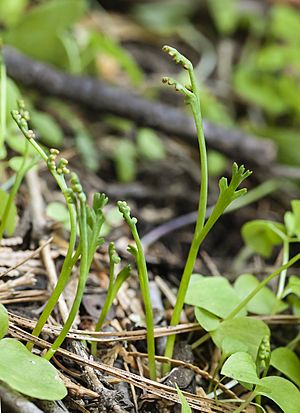Western goblin facts for kids
Quick facts for kids Western goblin |
|
|---|---|
 |
|
| Conservation status | |
| Scientific classification | |
| Genus: |
Botrychium
|
| Species: |
montanum
|
The Western Goblin (Botrychium montanum) is a tiny type of fern. It's also known as the mountain moonwort. This special plant belongs to a family of ferns called Ophioglossaceae. It's quite small and often hard to spot!
Contents
Discovering the Western Goblin Fern
The Western Goblin fern is a very small plant. It grows from a part of its stem that stays underground. This underground stem is called a caudex. From this hidden stem, the plant sends up just one thin, gray-green leaf.
Where the Western Goblin Grows
The Western Goblin fern lives in western North America. You can find it from British Columbia in Canada, down through Washington, Oregon, and northern California in the United States. It also grows in Montana and Idaho.
This fern likes to live in dark, moist places. It often grows in the shade under tall conifer trees. These are forests with trees like pines and firs. It also likes other damp, wooded areas.
How the Western Goblin Looks
The single leaf of the Western Goblin is very small. It usually stands less than 8 centimeters (about 3 inches) tall. This leaf is special because it has two main parts.
The Sterile Leaf Part
One part of the leaf is called the sterile part. This part is for making food for the plant using sunlight. It has small sections that are shaped a bit unevenly. They might look like small, angled pieces.
The Fertile Leaf Part
The other part of the leaf is called the fertile part. This part is very different. It's where the fern makes its spores. Spores are like tiny seeds that help the fern reproduce. This fertile part has clusters that look a bit like tiny grapes. These clusters are full of sporangia, which are little cases that hold the spores.
How the Western Goblin Reproduces
The Western Goblin fern reproduces using its spores. When the sporangia on the fertile part of the leaf open, they release these tiny spores. The spores can then grow into new fern plants if they land in a good, moist spot. This way, the fern can make more of itself without needing flowers or seeds.


